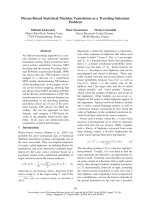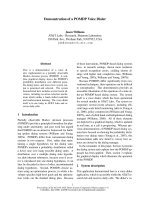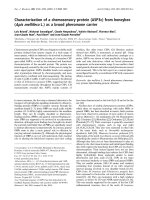Báo cáo khoa học: "DESIGN OF A MACHINE TRANSLATION SYSTEM " pptx
Bạn đang xem bản rút gọn của tài liệu. Xem và tải ngay bản đầy đủ của tài liệu tại đây (353.8 KB, 4 trang )
DESIGN OF A MACHINE TRANSLATION SYST~4 FOR A SUBIASK~A(~
Beat Bu~, Susan Warwick, Patrick Shann
Dalle Molle Institute for Semantic and Cognitive Studies
University of Geneva
Switzerland
ABSTRACT
This paper describes the design of a prototype
machine translation system for a sublanguage of
job advertis~nents. The design is based on the hy-
pothesis that specialized linguistic subsystems may
require special crmputational treatment and that
therefore a relatively shallow analysis of the text
may be sufficient for automatic translation of the
sublanguage. This hypothesis and the desire to mi-
nimize computation in the transfer phase has led to
the adoption of a flat tree representation of the
linguistic data.
1. INTRODUCTION
The most prcraising results in computational
linguistics and specifically in Machine Translation
(MT) have been obtained where applications were
limited to languages for special purposes and to
restricted text types (Kittredge, Lehrberger, 1982).
In light of these prospects, the prototype MT sys-
tem described below I should be seen as an experi-
ment in the ecnputational trea~nent of a particular
sublanguage. The project is meant to serve both as
a didactic tool and as a vehicle for research in
MT. The development of a large-scale operational
system is not envisaged at present. The following
research objectives have been defined for this
project:
- to establish linguistic specifications of the
sublanguage as a basis for automatic processing;
- to develop translation algorithms tailored to a
cc~putational treatment of the sublanguage.
The emphasis of the research lies in defining
the depth of linguistic analysis necessary to ade-
quately treat the ccrmplexity of the text type with
a view to acceptable machine translation. It is the
conjecture of our research group that, within the
particular sublanguage defined by our corpus, ac-
ceptable translation does not necessarily depend on
standard linguistic structural analysis but can be
obtained with a relatively shallow analysis. Thus,
as a working hypothesis, the principle of 'flat
trees' has been adopted for the representation of
the linguistic data. Flat trees, as opposed to deep
trees, only partially reflect the dependency strucn.
1
Project sponsored by the Swiss government.
ture obtained by a traditional IC-analysis. The
adoption of flat trees goes hand in hand with the
further hypothesis that the sublanguage can be
translated mechanically with only minimal semm~tic
analysis similarly to the
TAUM-M~'I%0
system
(Chevalier, et al., 1978).
2. THE SUBLAN(ETAGE
The corpus is taken from a weekly publication
by the Swiss goverrm~nt announcing federal job
openings. The wordload of this publication amounts
to ca. I0,000 words per week; however, many of the
advertisements are carried for several weeks. All
job adds are published in the three national lan-
guages: German, French and Italian, with German
usually serving as the source language (SL),
French and Italian as the target language (TL).
The study is hence based on a collection of texts
already translated by human translators. The ads
are grouped according to profession, e.g. academic,
technical, administrative, etc. At present, the
corpus is limited to the domain of administrative
positions, an example of which is given in figu-
re I.
Verwaltungsbeamtin
Fonctionnaire d'administration
Funzionaria amministrativa
FOhren des Sekretadates eines Sektionschefs. Ausfertigen yon
Korrespondenzen und 8erichten nach Diktat und Vorlage in
deutscher, franz6sischer und englischer Sprache, Abgeschlos-
sene kaufm~nnische Lehre oder Handelsschulbildung, Berufs-
erfahrung erwOnscht, Sprachen: Deutsch, Franz6sisch. Eng-
Iisch in Wort und Schrift. Italienisch und/oder Spanisch er-
w0nscht.
Diriger le secr(~tariat d'un chef de section. Dactylographier de
la correspondance allemande, franqaise et anglaise et des rap-
ports sous dictee ou d'apr@s manuscrits. Certificat d'ernployee
de commerce ou dipl6me d'une ecole de commerce, Exp@-
rience professionnelle d@sirbe. Langues: le fran~:ais, I'altemand
et I'anglais parles et ~crits. Connaissances de I'italien ou de
I'espagnol, voire des deux souhaitees.
Dirigere il segretariato di un capo sezione. Stesura di corri-
spondenza e rapporti secondo dettato o manoscritto. Tirocinio
commerciale o formazione commerciale. Pratica pluriennale.
Lingue: tedesco, francese, inglese (orale e seritto). Buone no-
zioni deil'itahano e/o dello spagnolo auspicate.
Figure i. Advertisement for an administrative
position ("Die Stelle", 1981).
334
The corpus exhibits many of the textual fea-
tures generally used to characterize a sublanguage,
i.e. (i) limited subject matter, (ii) lexical and
syntactic restrictions, and (iii) high frequency
of certain constructions. AS can be seen from the
example, the style of the sublanguage is distin-
guished by cc~plex nominal dependencies with va-
rious levels of coordination. In addition, most
sentences are inoc~lete in that they consist of a
series of nominal phrases and do not oontain a m~
verb; no relative phrases nor dependent clauses
occur. The inportance of nominal constituents is
reflected in the statistics of the German texts:
over 55% of the words in the corpus are nouns,
11% adjectives, 11% prepositions, 17% conjunctions ;
verbs only make up 1% of the corpus. A ccr~parison
with the statistics of the French and Italian
translations reveal approximately the sane distri-
bution except for infinitival venbs. The higher
frequency of verbs in French and Italian is due to
a preference for infinitival phrases in place of
deverbal nominal constructions. Apart from this
difference, the major textual characteristics
carry over from source to target sublanguage there-
by facilitating mechanical translation.
3. BRIEF DESCRIPTION OF THE SYb-i~4
Modem transfer-based MT systems are based on
the following design principles : (i) modularity,
e.g. separation of linguistic data and algorithms,
(ii) multilinguality i.e. independent analysis,
transfer, and generation phases, (iii) formalized
specification of the linguistic model (Hutchins,
1982). Although only a prototype, the system was
• designed in accordance with these considerations.
As to modularity, the software used is a gene-
ral purpose rule-based transducer especially deve-
loped for MT (Shann, Cod%ard, 1984). This software
tool not only allows for the separation of data
and algorithms but also provides great flexibility
in the organization of grammars and subgrammars,
and in the control of the cc~putational processes
applied to them.
As a multilingual system it is not directly
oriented towards any specific language pair; the
s~ne Gem1~n analysis module serves as input for
the German-French as well as the German-Italian
transfer module. Separate French and Italian gene-
ration modules use only language specific knowledge
to produce the final translation. However, the Ger-
man analysis is indirectly influenced by target
language considerations: the interface structure
between analysis and transfer was defined to take
advantage of the similarities between the three
languages and to accommodate the differences.
4.
L~ISTIC APPBDACH: MINIMAL BUT SUFFICIENT
DEPTH
With the sublanguage investigated displaying
restricted syntactic structures within a limited
semantic dcmain, a grammar specifically tailored to
these job advertisements can be defined. Moreover,
the linear series of nominal phrases as well as
the almost one-to-one lexical equivalences found
in the SL and TL texts suggest that a shallow ana-
lysis without a semantic component is sufficient
for adequate translation. The flat tree represen-
tation resulting from such a minimal depth ~;Tp~oach
does not make any claim to linguistic generaliza-
bility for purposes other than the translation of
this particular sublanguage.
4.1 Ccmputational considerations
In a transfer-based MT system, actual trans-
lation takes place in transfer and can be descri-
bed as the ocr~putaticnal manipulation of tree
structures. In the absenoe of any formal theory of
translation for MT, and given the relatively well-
developed analysis techniques currently available,
a major concern in Mr research is to minimize the
o~n~station neoessazy in the transfer phase. A
flat tree representation provides one way of sim-
plifying the structures to be processed; an inter-
faoe representation defined to acocmmodate both
SL and TL structures in the same manner, thus
avoiding tree structure manipulation, is yet ano-
ther means. The representation of the linguistic
data in this system is a direct result of these
two considerations.
4.2 Flat trees
The fact that the linearity of the surface
structure constituents carries o~r from SL to the
TLs justifies the adoption of a minimal depth ana-
lysis. The analysis is restricted to the identifi-
cation of the phrasal constituents and their inter-
nal structure; dependencies holding between consti-
tuents are only partially ccr~puted. Thus, the
interface structure resulting from analysis and
serving as input to transfer does not reflect a
linguistically correct dependency structure.
Instead, the IS respects the linear surface order
of the constituents (with the exception of predi-
cate groups, see below) in a flat tree represen-
tation.
In a flat tree, the major phrasal consti-
tuents, in particular the prepositional phrases,
are not attached at the node from which they de-
pend linguistically but at specified nodes higher
up in the tree. Schematically, the differences
can be illustrated as follows:
NP NP
N PP NP pp pp
\ t
i~ N
Fig. 2. Standard IC-tree vs. Flat tree
The flat tree representation applies to all three
mjor phrasal constituents defined for this cor-
pus: (i) nominal phrases proper, (ii) deverbal
335
ncminal phrases, and (iii) verbal phrases. Samples
taken from the oorpus are given below to illustrate
each of the three constituent structures.
(i) Ncminal phrases proper b~ve a standard noun
phrase as their head, possibly followed by a linear
sequence of prepositional phrases. (G~ stands for
both standard NPs and PPs. )
GN
~
Kauf~naennische mit in der
Ausbildung Erfahrung Verwaltung
(ii) Deverbal nominal phrases have a deverbal noun
as their head, followed by a linear sequence of GNs.
GDEV
GN (deverbal) GN GN
Schreiben yon nach
Texten Manuskrlpt
(iii) Verbal phrases have a predicate as their head,
followed by a linear sequence of GNs. (F~ enccrn-
passes predicative participles, predicative adjec-
tives, and infinitival predicates; the few finite
verbs in the corpus (0.4%) are not treated.)
GR~D
PRED GN G~
erwuenscht Erfahr%ulg in der
Datenverarbeitung
("Erfahrung in der Datenverarbeitung erwuenscht")
4.3 Normalized tree structures
In order to further minimize manipulation of
structure in transfer, the interface representation
is also normalized for two impo~t categories in
the sublanguage, narely deverbal ncminal phrases
(GDEV) and noun and prepositional phrases (~N). The
structures are defined such that they remain valid
for both the source and target language.
4.3.1 Devenbal nominal phrases
A marked stylistic difference between the SL
and the TLs occurring with high frequency in the
corpus is the translation of a German deverbal noun
into an infinitive in French and Italian. With the
deverbal noun in Gennan usually serving as the head
of a ccmplex D~minal structure with several ccsple-
ments, the translation of the noun into an infini-
tive in the target language changes the type of
cc~plement structure accordingly. The complete
linearization of the deverbal crmplements provides
a format for acccmrcdating the target language
infinitival construction aimed at in translation.
Structural transfer is thus reduced to renaming
the nodes; the normalized tree structure remains
the same, as can be seen in the SL and TL repre-
sentations shown below.
GDEV
GN ~ GN
Ueberwachen der hinsichtlich
Bestellungen Materiallieferungen
Fig. 3. SL (German) deverbal ncminal phrase
analysis.
GPRED
PRED GN G~
Surveiller les quant a la
oc~mandes livraison du materiel
Fig. 4. Equivalent TL (French) verbal phrase
analysis.
4.3.2 Noun ~hrases and prepositional phrases
Certain noun phrases in German (e.g. genetive
attributes) are translated into prepositional
phrases in French and Italian. In order to avoid
structural transfer of noun phrases into preposi-
tional phrases and vice-versa, a normalized form
for noun phrases has been defined which reserves
a position in the tree for prepositions. For stan-
dard noun phrases a special value (NIL) has been
defined to fill the empty preposition slot. There-
fore, in the transfer phase, a translation from a
noun Dhrase to a prepositional phrase or vice-
versa is merely a change in the value of the pre-
positional slot without any change in the tree
structure.
PREP N ART GN
Fig. 5. Example of the normalized form for
NPs and PPs.
4.4 CONSIDERATIONS FOR TRANSLATION
The goal of the system, and perhaps of MT in
general, has to be to carry over the information
content from SL to TL, to produce output acceptable
336
in terms of TL conventions, and to respect the
style of the text type. It seems that treating a
well-defined sublanguage enhances the possibili-
ties for an Mr system to answer these requirements.
In fact, the sublanguage itself suggests possible
strategies for dealing with some of the classical
translation problems in Mr such as (i) lexical
anbiguity, (2) translation of prepositions, and
(3) treatment of coordination.
4.4.1 Lexi~ip~lems
Two well-known lexical problems in computatio-
nal linguistics are homograph resolution and poly-
semy disambiguaticn. Given the small number of
possible syntactic structures in the sublanguage,
the few homographs found in the corpus do not pre-
sent any problems for analysis. In turn, the limi-
ted s~mantic danain of the sublanguage cc~pletely
eliminates multiple word senses so that the trans-
fer of lexical meanings is basically a one-to-one
mapping. Therefore, with the nouns serving as the
major carriers of the textual meaning, lexical
transfer ensures that the information content of
the text is carried over.
4.4.2 Translation of prepositions
The fact that the types of nouns occurring in
the sublanguage are restricted and repetitive and
that the possible prepositions commanded by any
given noun is small in nt~nber (max. 3 in the cor-
pus) allows the adoption of a limited noun-focused
approach for the translation of prepositions. In
such an approach, it is the particular noun or
noun class rather than general s~mantic features
that determine the translation of prepositions.
At present, the info~nation relevant to correct
translation of prepositions is attached to indi-
vidual noun entries in the transfer dictionary;
semantic noun subclassification similar to other
sublanguage research (Sager, 1982) is being
investigated.
4.4.3 Coordination
With SL and TLs exhibiting parallel surface
syntactic structure, and with inherent ambiguities
of scope therefore carrying over, analysis of co-
ordination remains shallow. Conjunctions and in-
trasentential punctuation are defined functionally
as coordinators to yield, in keeping with the flat
tree representation, a structure such as the one
shown below.
PH
O00RD G~ O00RD GN
Sprachen : Deutsch und Englisch in Wort
und Schri ft
Fig. 6. Coordinated structure at sentence level.
5. CONCLUSION
The evidence available to-date seem~ to show
that, for the particular sublanguage dealt with,
correct translation is feasible under the hypo-
theses described in this paper. The non-generali-
zability of such an approach is quite evident;
however, the fact that such a 'minimal depth' ap-
proach semns to work for this particular sublan-
guage gives substance to the impression that spe-
cialized linguistic subsystems differ quite
sharply, both in complexity and linguistic fea-
tures, frc~ the standard language and may there-
fore require special computational treatment.
P4~ENCES
Chevalier et al. T/K94-~'I'bO, Description du sys-
t/~re. Universit~ de Montreal, 1978.
EidgenSssisches Personalamt (ed.). Die Stelle.
Stellenzeiger des Bundes. No. 21, 1981.
Grist, R., Hirsdnman, L. and Frieclman, C.
"Natural Language Interfaces Using Limited
Semantic Information." Proc. 9th International
Conference on Computational Linguistics, 1982.
Hutchins, W.J. "Tne Evolution of Madline Transla-
tion Systems." In: Lawson, V. (ed.), Practical
Experience of Madnine Translation, Amsterdam,
N.Y., Oxford, 1982.
Kittredge, R., Lehrberger, J. (eds.). Sublangua-
@es, Studies of Lanuuage in Restricted Do-
mai'ns, Berlin, N.Y., 1982.
Sager, N. "Syntactic Formatting of Science Infor-
mation." In: Kittredge, Lehrburger, 1982.
Shann, P., Cochard, J.L. "GIT : A General Trans-
ducer for Teaduing Ccmputational Linguistics."
COLING Ccmmunication, 1984.
337









